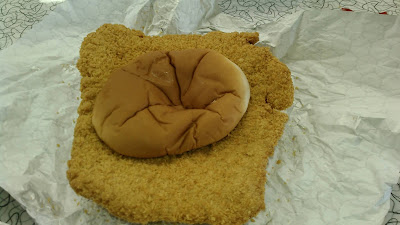It's not every day that a bunch of farm folk have high tea on fine china.
Well, it's not that way at our house anyway. I suppose I can't speak for every farm family.

Our National Master Farm Homemakers Guild conference attendees were treated to high tea at the Iowa governor's mansion, Terrace Hill. Iowa Governor Kim Reynolds and First Gentleman Kevin Reynolds do live in the mansion, but we didn't see them.
 |
Even the back of the house was fancy!
|
The
construction of Terrace Hill began in 1866 at the height of B.F.
Allen’s fortune. In October 1866, a local newspaper announced the
employment of workers to prepare a 29-acre site for Allen’s new home. It
described “a country residence in modern French design with a mansard
roof.” Another early newspaper source referred to a “fairy-land castle
with towers and turrets.” ... Allen selected Chicago architect William W. Boyington to design
Terrace Hill. Additionally, Job T. Elletson, a landscape gardener from
England, was hired to design the grass-plats, flower banks, vineyards
and orchards with graveled walks and drives throughout. It was completed in 1869.
From the Terrace Hill website


The mansion has been used as the governor's residence since 1971.
Even though it was opulent, there were a few signs that it's occupied by a family with young grandchildren. The pool area had a couple of bright-hued beach chairs, just right for watching the grandkids play in the water.
For high tea, our group was seated at tables of eight in the various public rooms of the mansion.

The tables were already set with china place settings and the high tea fare, which was stacked three plates high on servers.

The treats were prepared by Chef Sharon Van Verth and her staff. She has served several of the state's governors.

After tasting her scones with lemon curd, I can see why. The scones were moist, different than the dried-out texture of many scones I've had in the past. Of course, the moistness was helped along with the lemon curd we smeared on the scones.

The tea sandwiches ...

... and the other sweets were tasty as well. Another favorite at our table was the Scandinavian Almond Bars (which you can barely see in the center of the plate below).
My friend, Millie, got a better photo of her plate. (The almond bars were at the lower left in her photo below.)
 |
Photo by Millie Dearden
|
Once we'd emptied one of the plates, we discovered this farm scene. Maybe we weren't so far from the farm after all!

The tea servers did a wonderful job in tight quarters.

 |
| Photo by Millie Dearden |
 |
| Photo by Millie Dearden |
True confessions: Randy may not have gotten filled up with this meal. But he also didn't want to go to Iowa and not have a pork tenderloin sandwich. So, after we got back from our bus tours, he drove to Smitty's, which was supposed to have the best pork tenderloin sandwich in Des Moines.

He had some time to let his tea fare settle before his extracurricular trip. Our group toured the public floor and the gardens (and, of course, the gift shop).


They were renovating on the second floor, so it wasn't open, but the stained glass at the top of the staircase was beautiful.
We took our turn on the courting chair.
After we got home, I Googled, trying to find Chef Sharon's recipes online. But then I decided I'd go to the source. I requested the recipes from the governor's mansion itself. And I was delighted they shared them. They also noted the ones that I asked for are the most popularly requested.
I thought I'd share with you, too. I haven't tried them here at home yet.
Scones from Terrace Hill
2 cups flour
2 tbsp. sugar
1 tbsp. baking powder
1/8 tsp. salt
4 oz. butter, cut in eighths
2/3 cup cream
1/3 cup dried fruit (blueberries, cherries, cranberries)
Additional cream and sugar
Combine flour, sugar, baking powder, salt and butter in food processor. Process until butter crumbles and is distributed. Add cream and process just until dough starts to form. Place the mixture in a bowl. Add dried fruit. (The scones we were served had cranraisins.)
Form into circle on floured surface, about 1 inch thick. Cut into eight wedges.
Let sit for 15 minutes. Brush with additional cream and sprinkle with raw sugar.
Bake at 400 degrees about 15 minutes or until light golden brown.
Lemon Curd from Terrace Hill
1 cup butter
1/2 cup lemon juice
2 cups sugar
1 tbsp. (at least) grated lemon peel
3 eggs, lightly beaten
In double boiler, melt butter. Stir in sugar, eggs, lemon juice and peel. Cook over simmering water for 1 hour or until thickened, stirring occasionally. Pour into container and store in refrigerator. Spread over scones, biscuits or toasts. Makes 3 cups.
Scandinavian Almond Bars
1 3/4 cups flour
2 tsp. baking powder
1/4 tsp. salt
1/2 cup butter
1 cup sugar
1 egg
1/2 tsp. almond extract
1/2 cup sliced almonds
Milk
Almond icing
Stir together flour, baking powder and salt; set aside. Beat together butter and sugar. Add egg and almond extract, beating well. Add flour mixture and beat until dough forms. Divide dough into fourths. Form each into a 12-inch roll. Place 2 strands on ungreased cookie sheet. Flatten until 3 inches apart. Repeat with rest. Brush with milk and sprinkle with almonds.
Bake at 325 degrees for 12 to 14 minutes. While still warm, cut crosswise at a diagonal into 1-inch strips. Cool and drizzle with icing.
Icing
1 cup powdered sugar
1/4 tsp. almond extract
Water
Combine powdered sugar with extract. Add enough water to make icing that can be drizzled on cooled bars.






















































